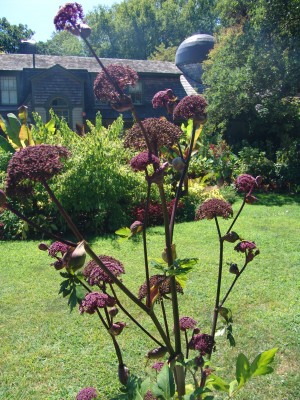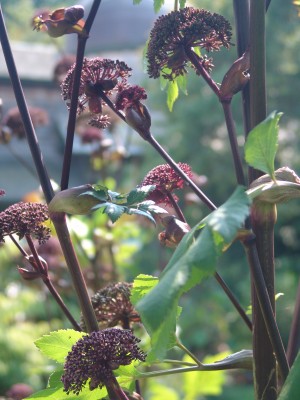Angelica gigas
Reflecting on my time so far as the curatorial intern (I just finished my second month here), I would say one of my favorite parts of the job is my daily interaction with Scott staff, volunteers, and visitors. Inquisitive visitors often stop to chat and ask me questions; if I were to tally all these questions, the top three would probably be:
1) “Excuse me – Could you please tell me how to get to the admissions office (Parrish Hall)?”
2) “Wow! What is that plant?” (Referring to Musa sikkimensis, our resident banana plant that we planted about 3 years ago and that we overwinter every winter)
3) “What is that odd-looking purple plant over there?”
The answer to this last question is our Plant of the Month, Angelica gigas or Korean angelica. This unique plant is a biennial that stands high at 3-6 feet tall, with purple, ribbed stems topped off with dark purple umbels. In its native homes of China, Japan, and Korea, angelica can be found in forests, grasslands, and alongside streams. In the home garden landscape, Angelica gigas offers a strong architectural form and a beautiful contrast when combined with finer-textured plants. It performs well in full sun to part shade, and prefers average to very rich soils. Angelica is difficult to propagate and its seeds do not store well, so it is best to leave angelica to self-sow and later edit out any undesirable plants. Bees, wasps, and butterflies love angelica’s fragrant flowers. Here at the Scott Arboretum, they are regularly visited by nectar-hungry wasps.
Beyond its aesthetic value, the dried root of angelica has been used for thousands of years as a valuable Chinese medicinal herb, said to aid heart, lung, and liver functions, as well as treat a number of women’s health issues. Today, in Korea, Angelica gigas is used to treat anemia. A recent Japanese pharmacological study even suggested a possible role that angelica’s essential oil could play in treating nicotine addiction. Angelica is not alone amongst garden plants possessing medicinal qualities. Hypericum (St. John’s Wort), Echinacea (purple coneflower and last month’s Plant of the Month), and Nepeta (catmint) species are said to possess a range of medicinal uses, making many gardens a veritable pharmacy! Come and visit us at the Scott Arboretum to see these plants and others…and when you do, be sure to stop and say hi (and maybe even ask a question!).







tricia
Posted at 19:30h, 10 JuneWonderful to behold and great story……absolutely fell in love when I saw the picture of ‘herself’ as a specimen planting
Ellen Wolf
Posted at 19:58h, 26 AugustMy Angelica gigas which was planted this past spring seems very happy but what kind of nectar-huingry wasps are they that are feasting all over the blossoms?
You mention these wasps in your plant-of-the-month description. They keep all other bees, wasps & butterfulies away as they swarm all over the blossoms.
They are thin, blackish looking from a distance but with numerous THIN yellow bands across the abdomen.
Thanks in advance
Ellen Wolf
Becky Robert
Posted at 10:48h, 31 AugustAngelica gigas, a member of the Apiaceae family, is known to attract a wide range of insects including wasps. Most of the wasp species are parasitoids of other insects, attacking the egg or larval stage of their host. The adult wasps voraciously feed on nectar and pollen and often “bully” other feeders out of the way. Identification can be daunting as there are so many wasps, many of which have yet to be formally identified. Based on your description, the wasp you described could be a beneficial in family Trigonalidae. A great reference site is Bug Guide hosted by Iowa State University Entomology. The database is comprehensive with great photographs. Another great feature is the ability to email photographs directly to them for identification.
BugGuide: http://bugguide.net/node/view/15740
Direct link to wasp page: http://bugguide.net/node/view/59
jean
Posted at 14:02h, 24 SeptemberI have a friend who gave me 2 angelicas. To me these are the most amazing plants. When they grew to 6 feet I was totally surprised. They don’t grow from the same plant every year. They make lil ones away from where they grew! Just love them
Jennifer @ Oil Diffuser
Posted at 22:57h, 19 JuneAngelica gigas is so amazing tree. I have ever known this tree, and I am so happy to learn about wonderful benefits from this tree. Wow, It can be good for human life through curing health issues, remaining beautiful skin, and be good for soils. I really love this tree. Thank you for your sharing
Becky Robert
Posted at 09:36h, 25 JuneThank you for the compliment Jennifer, but Angelica gigas is actually a biennial that stands high at 3-6 feet tall.
Happy Planting,
Becky Robert
PR and Volunteer Programs Coordinator